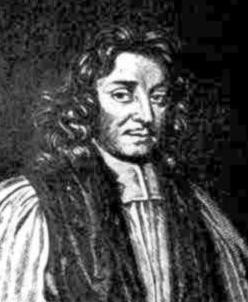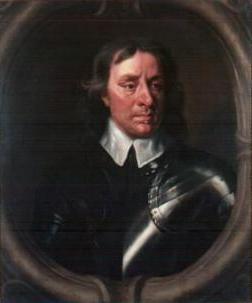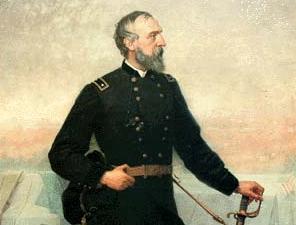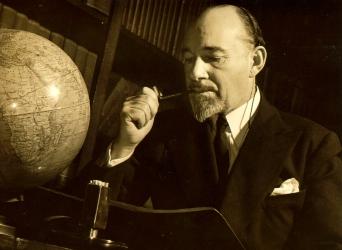Tom's Ancestry
by Thomas Huff
My parents had told me that I was related to Oliver Cromwell, who was one of Britain's most famous historical figures, and General George Meade, for whom a fort near my house is named.
They never told me just how that relationship took shape though.
One day I decided to set out to find these folks in my lineage and I not only discovered them but a couple other notable mugs.
Here are some quick bios on some select folks.
Bishop John Wilkins (1614-1672), famous inventor, linguist, founder of England's Royal Society and my 8th great-grandfather, he chaired the founding meeting of the Royal Society and was its first secretary. He was the only person to have been head of a college in both Cambridge and Oxford. He was Warden of Wadham College in Oxford and then Master of Trinity College in Cambridge but was deposed at the Restoration in 1660: he had married Oliver Cromwell's sister, and this did not endear him to returning royalty.
John Wilkins graduated from Oxford University as a Bachelor of Arts when he was only 17 years old. At 24 he published a book about the possibility of a journey from the earth to the moon. He later published a book called Mathematical Magick in which he wrote a chapter about navigating the Arctic by submarine. That was over two centuries before Jules Verne astonished the world with his "creative imagination."
He also wrote a book on a universal language that amongst other things contained an exhaustive classification of notions in all spheres of thought. P. M. Roget clearly based his Thesaurus on this book. And later the work inspired Ludwik Lejzer Zamenhof's Esperanto.
Wilkins' book, A Discourse Concerning a New Planet, Tending to Prove That Our Earth Is One of the Planets was the first presentation in England of that idea, and was met with a storm of ridicule, as it was commonly accepted that the earth was stationary and the sun and stars revolved about it.
He is of interest to cryptographers because he wrote a book called Mercury, or the Secret and Swift Messenger, which is described in David Kahn's historical book, The Codebreakers, as "the first book in English on cryptography." The policies set forth in this book are still pertinent today.
He was probably the first to write about different number bases (binary and ternary) and how to encode all the letter of the alphabet into five-bit segments that could be transmitted by any means available. This, of course, laid the ground work for Morse code, the telegraph and later, the computer.
Oliver Cromwell (1599-1658), Lord Protector of England and the brother of my 8th great-grandmother, was a leader in the English Revolution (1640-1660) and the first commoner to rule England. Cromwell governed as Lord Protector from 1653 to 1658 under England's only written constitution, the Instrument of Government. During the English Civil War (1642-1648), Cromwell rose from obscurity on the basis of his devout Calvinism, natural military genius, and forceful personality. These characteristics helped him hold together the competing groups that had overthrown King Charles I in the first phase of the civil war. Cromwell conquered Ireland and Scotland, made England a feared military power in Europe, and expanded its overseas empire. He refused to rule without constitutional authority. His civilian government introduced electoral reform, moderate religious toleration, and the first truly British Parliament. The revolution that he guided did not survive him, and after a period of political chaos he was succeeded by the restoration of Charles II to the throne.
Hepzibah "Heppie" Wilkins (1840-1917), first high school graduate in Pittsburgh and sister of my 2nd great-grandfather. In 1855, when the old Central High School was established on the second floor of a building in Pittsburgh, she was among 115 boys and girls whose names were enrolled as high school pupils. They were broken up into four classes based on merit in which Heppie was placed in the most advance; the 'A' class. There were 34 pupils in the 'A' class. After two years the class numbered five--Heppie Wilkins and four boys. At the end of the third year, only Heppie and two others remained. These three were the only members of the graduating class of 1859. On July 1, 1859, Heppie received the very first High School Diploma ever presented in Pittsburgh.
The work for high school students in Pittsburgh in 1855 was far more difficult than educators would think of prescribing for the youth of today. It included many of the subjects found now only in university courses. The achievement of Heppie Wilkins in completing the Pittsburgh Central High School in four years is one of the many incidents which link her name prominently with the educational development of the city.
Shortly after Heppie's death, the diploma was presented to the Carnegie Museum by Mary Wilkins, her half-sister. It was hung as a memorial in a conspicuous place in the Museum.
General George Gordon Meade (1815-1872), Commander of the Army of the Potomac and my 2nd cousin three times removed, was an American army officer, born in Cadiz, Spain, and educated at the U.S. Military Academy. He joined the Union forces at the outbreak of the American Civil War, participating in the defense of Washington, D.C., in 1861. As a major general of volunteers he fought at the Battle of Chancellorsville in 1863 and shortly thereafter was appointed commander of the Army of the Potomac by President Lincoln. In July 1863, in the battle that is considered the turning point of the war, he defeated Confederate forces lead by General Robert E. Lee at Gettysburg, Pennsylvania. He continued as commander of the Army of the Potomac, working closely with General Ulysses S. Grant, until the end of the war. Promoted to major general in the regular army in 1864, Meade commanded various military departments in the U.S. until his death.
Just before the First World War, the State of Pennsylvania unveiled the Meade Memorial, a large equestrian statue, in Washington D.C., located on the Mall in front of the Capitol Building, just south of the Grant Memorial.
Sir George Hubert Wilkins (1888-1958), legendary Australian explorer, aviator and my 3rd cousin twice removed, made his first expedition to Antarctica in 1920. He was the leader of an expedition that made a biological survey of tropical Australia from 1923 to 1925. Returning to the Arctic regions in 1926, he pioneered in aerial exploration of the polar regions. In 1928 Wilkins and his pilot Carl Benjamin Eielson, flew from Point Barrow, Alaska, to Spitsbergen, a Norwegian archipelago. The 3380-km (2100-mi) flight over largely unexplored Arctic waters was the first to be made from North America to the European polar regions. Wilkins was knighted in 1928 for this feat. Later that year he made aerial explorations of Antarctica. In 1929 he was aboard the Graf Zeppelin on its around the world flight. In 1931 he made an unsuccessful attempt in the submarine Nautilus to explore the area under the North Pole. He was manager of the trans-Antarctica expeditions of the American explorer Lincoln Ellsworth from 1933 to 1939. And was a dignitary aboard the airship Hindenburg on its maiden voyage to the United States in 1936. During and after World War II he served as a consultant on arctic problems to the U.S. Army. He made his last trip, an exploration of Antarctica, in 1957. Wilkins's writings include Undiscovered Australia (1928), Flying the Arctic (1928), and Under the North Pole (1931).
Biographical Sources:
"Cromwell, Oliver." Microsoft Encarta Encyclopedia 2001. © 1993-2000 Microsoft Corporation. All rights reserved.
"Meade, George Gordon." Microsoft Encarta Encyclopedia 2001. © 1993-2000 Microsoft Corporation. All rights reserved.
"Wilkins, Sir George Hubert." Microsoft Encarta Encyclopedia 2001. © 1993-2000 Microsoft Corporation. All rights reserved.




